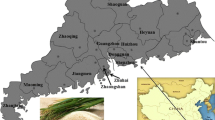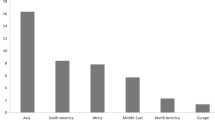Abstract
This study examined the total arsenic (Ast) and inorganic arsenic (Asi) content in the main rice growing area of China. The results were compared with other countries and then used for dietary exposure assessment. A total of 446 rice samples from 15 main rice-growing provinces and autonomous regions of China were collected and then divided into unpolished and polished rice. Total arsenic and arsenic species were analyzed in a total of 892 subsamples using inductively coupled plasma-mass spectrometry (ICP-MS) and high performance liquid chromatography (HPLC) coupled ICP-MS, respectively. National Ast means were 255 μg/kg of unpolished rice and 143 μg/kg of polished rice. Asi was found to be the predominant species and mean levels were 209 μg/kg of unpolished rice and 108 μg/kg of polished rice, respectively. Exposure assessment to Asi in polished rice has been calculated for the margin of exposure (MOE), which highlights the fact that Asi levels in the Chinese rice should arouse public health concern.
Similar content being viewed by others
References
Chatterjee D, Halder D, Majumder S, Biswas A, Nath B, Bhattacharya P, Bhowmicka S, Mukherjee-Goswamia A, Sahaa D, Hazraa R, Maityd P, Chatterjeee D, Mukherjeef A, Bundschuh J. Assessment of arsenic exposure from groundwater and rice in Bengal Delta Region, West Bengal, India. Water Res, 2010, 44:5803–5812
Breslow N, Day N. Statistical Methods in Cancer Research. Vol. 2. Lyon: IARC, 1987
Chen CJ, Wang CJ. Ecological correlation between arsenic level in well water and age-adjusted mortality from malignant neoplasms. Cancer Res, 1990, 50:5470–5474
Chen GQ, Zhou L, Styblo M, Walton F, Jing Y, Weinberg R, Chen Z, Waxman S. Methylated metabolites of arsenic trioxide are more potent than arsenic trioxide as apoptotic but not differentiation inducers in leukemia and lymphoma cells. Cancer Res, 2003, 63:1853–1859
Nishikawa T, Wanibuchi H, Ogawa M, Kinoshita A, Morimura K, Hiroi T, Funae Y, Kishida H, Nakae D, Fukushima S. Promoting effects of monomethylarsonic acid, dimethylarsinic acid and trimethylarsine oxide on induction of rat liver preneoplastic glutathione S-transferase placental form positive foci: a possible reactive oxygen species mechanism. Int J Cancer, 2002, 100:136–139
Gallagher PA, Wei X, Shoemaker JA, Brockhoff CA, Creed JT. Detection of arsenosugars from kelp extracts via IC-electrospray ionization-MS-MS and IC membrane hydride generation ICP-MS. J Anal At Spectrom, 1999, 14:1829–1834
Meharg AA, Lombi E, Williams PN, Scheckel KG, Feldmann J, Raab AZ, Zhu Y, Islam R. Speciation and localization of arsenic in white and brown rice grains. Environ Sci Techno, 2008, 42:1051–1057
Schoof R, Yost L, Eickhoff J, Crecelius E, Cragin D, Meacher D, Menzel D. A market basket survey of inorganic arsenic in food. Food Chem Toxicol, 1999, 37:839–846
Tao SSH, Bolger PM. Dietary arsenic intakes in the United States: FDA total diet study, September 1991–December 1996. Food Addit Contam, 1999, 16:465–472
Heitkemper DT, Vela NP, Stewart KR, Westphal CS. Determination of total and speciated arsenicin rice by ion chromatography and inductively coupled plasma mass spectrometry. J Anal At Spectrom, 2001, 16:299–306
Smith NM, Lee R, Heitkemper DT, DeNicola Cafferky K, Haque A, Henderson AK. Inorganic arsenic in cooked rice and vegetables from Bangladeshi households. Sci Total Environ, 2006, 370:294–301
Williams P, Price A, Raab A, Hossain S, Feldmann J, Meharg A. Variation in arsenic speciation and concentration in paddy rice related to dietary exposure. Environ Sci Technol, 2005, 39:5531–5540
Abedin, MJ, Feldmann J, Meharg AA. Uptake kinetics of arsenic species in rice plants. Plant Physiol, 2002, 128:1120–1128
Bednar A, Garbarino J, Ranville J, Wildeman T. Presence of organoarsenicals used in cotton production in agricultural water and soil of the southern United States. J Agric Food Chem, 2002, 50:7340–7344
Lee JS, Lee SW, Chon HT, Kim KW. Evaluation of human exposure to arsenic due to rice ingestion in the vicinity of abandoned Myungbong Au-Ag mine site, Korea. J Geochem Explorat, 2008, 96:231–235
Marin A, Masscheleyn P, Patrick W. The influence of chemical form and concentration of arsenic on rice growth and tissue arsenic concentration. Plant Soil, 1992, 139:175–183
Odanaka Y, Tsuchiya N, Matano O, Goto S. Characterization of arsenic metabolites in rice plant treated with DSMA (disodium methanearsonate). J Agric Food Chem, 1985, 33:757–763
Williams P, Raab A, Feldmann J, Meharg A. Market basket survey shows elevated levels of As in South Central US processed rice compared to California: consequences for human dietary exposure. Environ Sci Technol, 2007, 41:2178–2183
Li Y. Research and practice of water-saving irrigation for rice in China. In: Barker R, Loeve R, Li YH, Tuong TP, Eds. Water-Saving Irrigation for Rice: Proceedings of an International Workshop Held in Wuhan, China. Wuhan: International Water Management Institure, 2011. 23–25
Lin HT, Wong SS, Li GC. Heavy metal content of rice and shellfish in Taiwan. J Food Drug Anal, 2004, 12:167–174
The National Bureau of Statistics. National food production Gazette (in Chinese). http://www.gov.cn/gzdt/2011-12/02/content2008844.htm. 2011-12-02
Zhu YG, Sun GX, Lei M, Teng M, Liu YX, Chen NC, Wang LH, Carey AM, Deacon C, Raab A, Meharg AA, Williams PN. High percentage inorganic arsenic content of mining impacted and nonimpacted Chinese rice. Environ Sci Technol, 2008, 42:5008–5013
Cheng W, Zhang G, Yao H, Dominy P, Wu W, Wang R. Possibility of predicting heavy-metal contents in rice grains based on DTPA-extracted levels in soil. Commun Soil Sci Plant Anal, 2004, 35:2731–2745
Huang RQ, Gao SF, Wang WL, Staunton S, Wang G. Soil arsenic availability and the transfer of soil arsenic to crops in suburban areas in Fujian Province, southeast China. Sci Total Environ, 2006, 368:531–541
Li G, Sun GX, Williams PN, Nunes L, Zhu YG. Inorganic arsenic in Chinese food and its cancer risk. Environ Int, 2011, 37:1219–1225
World Health Organization. Guidelines for Drinking-Water Quality. 3 ed. Geneva: WHO, 2006. p488–493
Juhasz AL, Smith E, Weber J, Rees M, Rofe A, Kuchel T, Sansom L, Naidu R. In vivo assessment of arsenic bioavailability in rice and its significance for human health risk assessment. Environ Health Perspect, 2006, 114:1826–1831
Yang XG, Zhai FY. The Second China National Nutrition and Health Survey Report: Diet and Nutrient Intake Status in 2002. Beijing: People’s Medical Publishing House, 2006
Batista BL, Souza JMO, De Souza SS, Barbosa F. Speciation of arsenic in rice and estimation of daily intake of different arsenic species by Brazilians through rice consumption. J Hazard Mater, 2011, 191:342–348
D’Amato M, Forte G, Caroli S. Identification and quantification of major species of arsenic in rice. J AOAC Int, 2004, 87:238–243
Sanz E, Munoz-Olivas R, Camara C, Sengupta MK, Ahamed S. Arsenic speciation in rice, straw, soil, hair and nails samples from the arsenic-affected areas of Middle and Lower Ganga plain. J Environ Sci Health A, 2007, 42:1695–1705
FAPAS. Protocol for Proficiency Testing Schemes. 2 ed. Sand Hutton, YORK: Fera Science Ltd., 2010
Liang F, Li Y, Zhang G, Tan M, Lin J, Liu W, Li Y, Lu W. Total and speciated arsenic levels in rice from China. Food Addit Contam, 2010, 27:810–816
Ministry of Health. National Food Safety Standard Maximum Levels of Contaminants in Food. GB 2762-2012. Beijing: Standards Press of China, 2012
Heinemann R, Fagundes P, Pinto E, Penteado M, Lanfer-Marquez U. Comparative study of nutrient composition of commercial brown, parboiled and milled rice from Brazil. J Food Comp Anal, 2005, 18:287–296
Codex Committee on Contaminants in Foods. Discussion Paper on Arsenic in Rice. Codex Committee on Contaminants in Foods, 5 th Session. CX/CF/11/5/10. Hague, Netherlands, 2011
Codex Committee on Contaminants in Foods. Proposed Draft Maximum Levels for Arsenic in Rice. Codex Committee on Contaminants in Foods, 6 th Session. CX/CF/12/6/8, 2012
Codex Committee on Contaminants in Foods. Proposed Draft Maximum Levels for Arsenic in Rice (Raw and Polished Rice). Codex Committee on Contaminants in Foods, 8th Session. CX/CF/14/8/6, 2014
EFSA. Scientific Opinion on Arsenic in Food. EFSA Panel on Contaminants in the Food Chain (CONTAM), 2009:1351–1550
World Health Organization. Evaluation of certain food additives and contaminants in food. Seventy-second report of the Joint FAO/WHO Expert Committee on Food Additives. WHO Technical Report Series. Rome, 2011
Author information
Authors and Affiliations
Corresponding author
Rights and permissions
About this article
Cite this article
Li, X., Xie, K., Yue, B. et al. Inorganic arsenic contamination of rice from Chinese major rice-producing areas and exposure assessment in Chinese population. Sci. China Chem. 58, 1898–1905 (2015). https://doi.org/10.1007/s11426-015-5443-5
Received:
Accepted:
Published:
Issue Date:
DOI: https://doi.org/10.1007/s11426-015-5443-5




